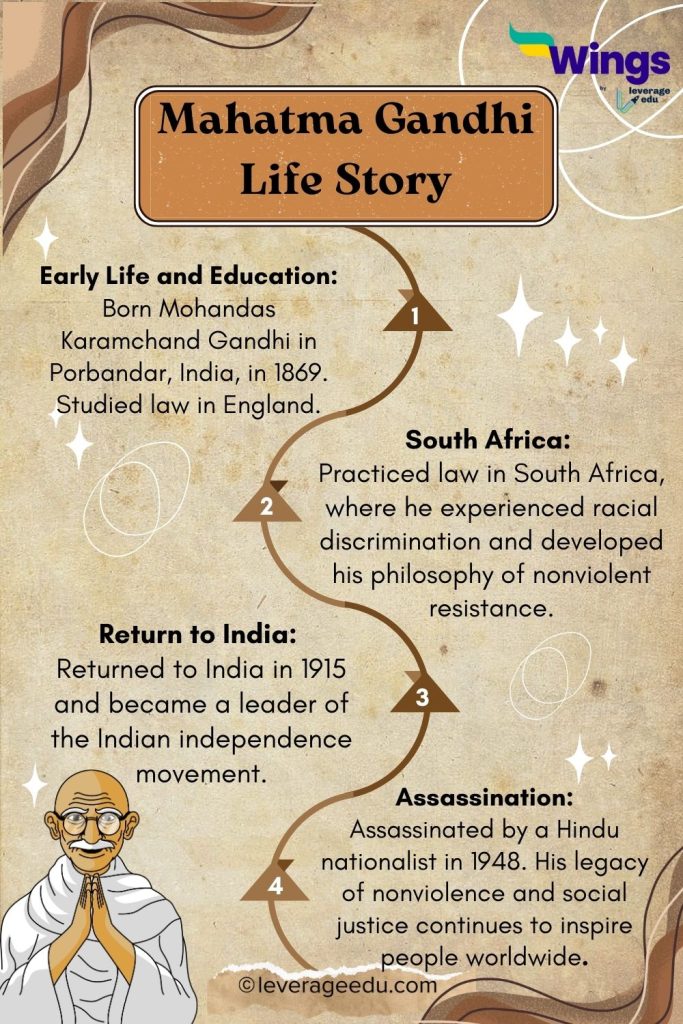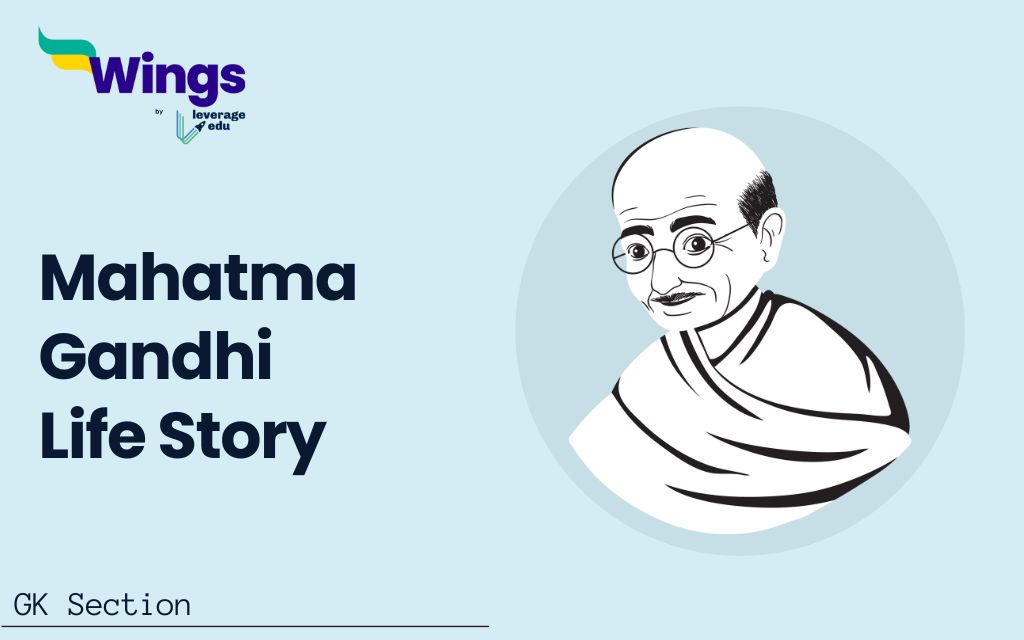Mahatma Gandhi, known as the Father of the Nation in India, was an important figure in the country’s independence movement. His philosophy of nonviolent resistance, known as Satyagraha, inspired millions worldwide and played an important role in India’s struggle for freedom from British colonial rule. Gandhi’s life and work continue to be celebrated and studied, making him a frequent topic in various competitive exams, including the UPSC, SSC and other general knowledge-based exams. In this blog, you will find all of the essential facts that you need to know about Mahatma Gandhi life story.
Contents
Who is Mahatma Gandhi?
Mahatma Gandhi was a prominent Indian leader who played an important role in India’s independence movement. He is often referred to as the “Father of the Nation” for his leadership and advocacy of nonviolent resistance. Gandhi’s philosophy of Satyagraha, which emphasizes truth and nonviolence, inspired millions worldwide and helped India achieve independence from British colonial rule.Continue reading to learn more about Mahatma Gandhi life story.

Early Life and Education
Mahatma Gandhi’s early life was shaped by his family’s Jain and Hindu traditions. He was born Mohandas Karamchand Gandhi in Porbandar, India, in 1869. Gandhi married Kasturba Gandhi at a young age.
In 1888, at the age of 19, Gandhi left India to study law in England. During his time in England, he was exposed to Western culture and ideas, which influenced his thinking and development. He returned to India in 1891, determined to use his legal skills to serve his country. Some important details regarding his early life and education are stated below:
- Family background: Gandhi’s family belonged to the Vaishya caste and practiced Jainism and Hinduism.
- Early education: Gandhi received his primary education in Porbandar.
- Law studies: Gandhi studied law at the Inner Temple in London.
- Exposure to Western culture: Gandhi’s time in England exposed him to Western ideas and values, which influenced his thinking.
- Return to India: Gandhi returned to India in 1891, determined to use his legal skills to serve his country.
South Africa and the Development of Satyagraha
After completing his studies in England, Mahatma Gandhi moved to South Africa in 1893 to practice law. There, he experienced firsthand the discrimination and prejudice faced by Indians, leading him to develop his philosophy of Satyagraha. Important pillars of his philosophy of satyagraha are :
- Discrimination against Indians: Gandhi witnessed the racial discrimination and segregation faced by Indians in South Africa.
- Development of Satyagraha: Gandhi’s experiences in South Africa led him to develop the philosophy of Satyagraha, which emphasizes nonviolent resistance as a means to achieve justice and social change.
- Civil disobedience: Gandhi organized various nonviolent protests, including the Natal Indian Congress and the Passive Resistance Movement, to challenge discriminatory laws and practices.
- Imprisonment: Gandhi was repeatedly arrested and imprisoned for his activism.
- Growth of Satyagraha: Gandhi’s experiences in South Africa helped him refine and develop the principles of Satyagraha, which would later become a powerful tool in India’s independence movement.
Return to India and the Independence Movement
In 1915, Mahatma Gandhi returned to India and joined the Indian National Congress, a political party striving for Indian independence. He quickly emerged as a leader, organizing various nonviolent protests, including the Salt March and the Quit India Movement.
- Joining the Indian National Congress: Gandhi joined the Indian National Congress upon his return to India.
- Nonviolent protests: Gandhi led various nonviolent protests, such as the Salt March and the Quit India Movement, to challenge British colonial rule.
- Leadership: Gandhi emerged as a prominent leader of the Indian independence movement.
- Civil disobedience: Gandhi’s protests were based on civil disobedience and nonviolent resistance.
- Nationalism: Gandhi’s leadership helped to unite Indians and inspire a sense of nationalism.
Notable Achievements of Mahatma Gandhi
Mahatma Gandhi’s life was marked by many significant achievements that contributed to India’s independence and the global movement for nonviolent resistance. Here are some of his most important accomplishments with their corresponding dates:
- Development of Satyagraha: Gandhi’s philosophy of nonviolent resistance, known as Satyagraha, began to take shape during his time in South Africa in the early 20th century, particularly through his experiences with the Natal Indian Congress.
- Leadership of the Indian Independence Movement: Gandhi emerged as a prominent leader of the Indian independence movement in the 1920s and 1930s. He became the president of the Indian National Congress in 1921.
- Salt March: The Salt March took place from March 12 to April 6, 1930, protesting the British salt monopoly.
- Quit India Movement: The Quit India Movement was launched on August 8, 1942, calling for the British to leave India immediately.
- Promotion of Social Justice: Gandhi’s work for social justice, including the upliftment of marginalized communities, spanned his entire career. He championed the cause of the “Harijans,” or “children of God,” a term he used for the untouchables.
- Global Influence: Gandhi’s philosophy of nonviolent resistance began to inspire leaders and activists around the world in the mid-20th century. Martin Luther King Jr., for example, was deeply influenced by Gandhi’s teachings.
- Enduring Legacy: Gandhi’s legacy continues to be celebrated and studied, with his ideas remaining relevant in today’s world.
Important Contributions of Mahatma Gandhi
Mahatma Gandhi’s legacy extends far beyond India. His philosophy of nonviolent resistance, known as Satyagraha, has inspired leaders and activists around the world, including Martin Luther King Jr. and Nelson Mandela. Gandhi’s contributions to Indian independence and his commitment to social justice continue to be celebrated and studied.Here we have listed his notable contributions in detail:
- Satyagraha: Gandhi’s philosophy of nonviolent resistance has inspired leaders and activists worldwide.
- Global influence: Gandhi’s legacy extends beyond India and has had a significant impact on global movements for justice and equality.
- Social justice: Gandhi was committed to social justice and worked for the upliftment of marginalized communities.
- Environmentalism: Gandhi was an early advocate for environmentalism and emphasized the importance of sustainable living.
- Human rights: Gandhi’s principles of nonviolence and human rights continue to be relevant in today’s world.
Assassination and Legacy
Mahatma Gandhi’s commitment to nonviolence and his efforts to promote social equality and unity earned him widespread respect and admiration. However, his views on communal harmony and Hindu-Muslim unity were met with opposition from some extremist groups. Tragically, Gandhi was assassinated by a Hindu nationalist in 1948.
FAQs
Mahatma Gandhi was famous for his philosophy of nonviolent resistance, known as Satyagraha. He led India’s independence movement and inspired leaders worldwide with his commitment to peace and social justice.
Mahatma Gandhi was a leader, activist, and philosopher who is revered as the Father of the Nation in India. He is known for his philosophy of nonviolent resistance, known as Satyagraha, which played an important role in India’s independence movement.
Mahatma Gandhi’s most famous slogan is “We shall either free India or die in the attempt”.
RELATED BLOGS
| Essay on Mahatma Gandhi | Education of Mahatma Gandhi |
| Facts About Mahatma Gandhi | Thought of the Day by Mahatma Gandhi |
| Quotes by Mahatma Gandhi | Autobiography of Mahatma Gandhi |
This was all about the “Mahatma Gandhi Life Story”. For more such informative blogs, check out our UPSC Exams Section and Study Material Section, or you can learn more about us by visiting our Indian exams page.
 One app for all your study abroad needs
One app for all your study abroad needs














